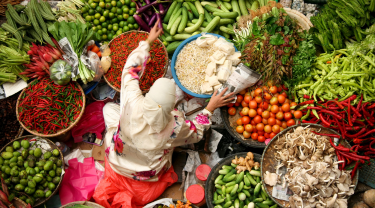By all accounts, the era of uncertainty is upon us. The Policy Uncertainty Index, which tracks the frequency of the term “uncertain” in major Canadian newspapers, has reached heights unmatched since its inception 40 years ago.
The neoliberal consensus that ushered in the 21st century, which emphasized open societies, free markets, and international integration and co-operation, has been put to the test. The aftermath of the 2008 global financial crisis cast doubt on the promise of globalization to deliver growth and prosperity for all. The COVID-19 pandemic further reinforced these disparities, with wealthier households accumulating more wealth while those at the lower end watched their pandemic savings vanish and debt levels rise.
In response, populism has surged and economic growth is increasingly seen as a zero-sum game with clear winners and losers. This has led to a beggar-thy-neighbour approach to policy-making, creating a race to the bottom that hinders co-operation on critical issues such as climate change, disruptive technologies, national security, dealing with the world’s many refugee crises and international trade.
Diversification strategies for uncertain times
While Canadian exporters have proven adept at managing both the ups and downs of the economic cycle, managing uncertainty is a more complex challenge. So, what can they do in these unprecedented times? As any good portfolio manager will advise: Diversify.
We’re fortunate to live on the doorstep of the world’s largest market, sharing integrated transport networks, a common business culture, compatible regulations and close people-to-people ties. It’s no surprise, then, that 77% of our goods exports and 51% of our services exports head south of the border. In 2023, out of nearly 49,000 merchandise exporters, 41,482 exported to the United States.
But in a world fraught with uncertainty, that same portfolio manager will tell you it’s unwise to have three-quarters of your portfolio concentrated in one asset. Forced to rethink our allocations, where can Canadian exporters look to reduce risk and ensure long-term growth? International trade models, which are used to predict bilateral trade flows based on market size and the distance between countries, highlight several high-potential markets for Canadian companies.
High-potential export markets for Canadian businesses
In the traditional space, Europe offers numerous opportunities. In fact, 18 of the 50 markets with the greatest potential for Canadian exports over the second half of the decade are European. Together, these 18 markets present nearly $85 billion in goods export potential for Canada by 2029. This represents nearly 50% growth in export potential compared to the average levels of Canadian goods exports between 2018 and 2023. This list includes the usual European markets generally favoured by Canadian exporters, such as the United Kingdom, France, Germany, Spain and Italy. But it also points to other markets, like Belgium, Netherlands, Poland, Ireland and Türkiye.
When assessing portfolio allocation, in addition to the value plays, it’s always wise to consider growth elements as well. We need to reflect on trends such as demographics, wealth accumulation, urbanization, technological disruption and the availability of land, labour and capital.
You should also check out
Explore high-potential markets and strategies to grow internationally while managing risks.
The Indo-Pacific region, for example, is home to some of the world’s fastest-growing economies. Thirteen of the Top 50 export potential markets for Canada are in this region, collectively offering more than $83 billion in goods export potential by 2029. This includes markets such as Australia, China, India, Japan, Singapore and South Korea, as well as the rapidly growing and dynamic markets of Vietnam, Indonesia, Philippines, Thailand and Malaysia.
Over the past five years, annual growth rates in many of these markets have far surpassed those of our traditional trade partners. Our forecasts indicate that these markets will continue to grow rapidly through the rest of this decade. Even more importantly, these markets’ goods imports are expected to rise steadily, growing at a compounded annual rate of 5% through 2029. This fact alone should put the Indo-Pacific at the top of any Canadian goods exporters’ list of target markets.
Markets in other regions also hold considerable promise. For instance, Brazil, Chile, Argentina, Panama and Colombia together offer nearly $12 billion in potential for Canadian goods exporters by 2029. Similarly, Saudi Arabia, South Africa and the United Arab Emirates combined provide almost $6 billion in goods export potential. These are all markets that Canadian exporters should consider prioritizing.
The bottom line
Shifting geopolitics and a new mercantilist global order has placed international trade squarely in its crosshairs. The resulting increase in uncertainty means that Canadian exporters must reconsider the diversification of their portfolio mix to future-proof their exposures. EDC stands ready to support Canadian businesses looking to grow in these uncertain times. Whether by expanding our regional presence in the Indo-Pacific, or through our range of financial and advisory products, we’re taking on more risk so that Canada can focus on growth.
This week, a very special thanks to Meena Aier and Jean Victor. As always, at EDC Economics, we value your feedback. If you have ideas for topics that you’d like us to explore, please email us at economics@edc.ca and we’ll do our best to cover them.
This commentary is presented for informational purposes only. It’s not intended to be a comprehensive or detailed statement on any subject and no representations or warranties, express or implied, are made as to its accuracy, timeliness or completeness. Nothing in this commentary is intended to provide financial, legal, accounting or tax advice nor should it be relied upon. EDC nor the author is liable whatsoever for any loss or damage caused by, or resulting from, any use of or any inaccuracies, errors or omissions in the information provided.





